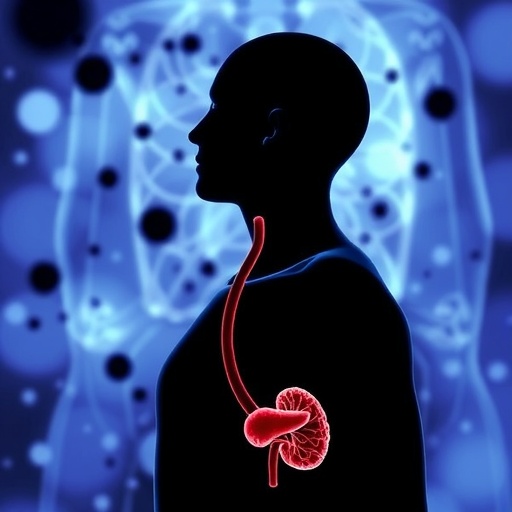
A groundbreaking study recently published in BMC Cancer unveils critical insights into how smoking influences breast cancer screening outcomes among women in Wu Wei, China. This research not only deepens our understanding of the complex interplay between lifestyle factors and cancer detection but also offers valuable implications for refining local cancer prevention strategies. Employing sophisticated pathway analysis grounded in Anderson’s behavioral model, the study analyzes data collected from nearly 1,800 women, revealing that smoking dramatically increases the likelihood of detecting breast-related lesions during routine screening.
Breast cancer, a major global health concern, demands continuously evolving screening programs to improve early detection and reduce mortality. This investigation specifically targets the female population in Wu Wei, providing a regional lens that encapsulates socioeconomic and behavioral variables rarely examined in concert before. With a detection rate of approximately 20% for breast-related diseases among participants, researchers have managed to construct a nuanced model illustrating how smoking mediates and exacerbates risks, especially when intersecting with education levels.
The authors employed Anderson’s model to create a pathway analysis that identifies direct and indirect effects of smoking on screening outcomes. Anderson’s framework, widely recognized for its utility in healthcare utilization studies, allows for detailed examination of predisposing characteristics, enabling behaviors, and health outcomes. By deploying this analytical approach, the research transcends simple correlation studies, revealing smoking’s role as both a direct contributor to pathological detection and a mediator modulated by educational attainment.
.adsslot_ksmvfnUda0{width:728px !important;height:90px !important;}
@media(max-width:1199px){ .adsslot_ksmvfnUda0{width:468px !important;height:60px !important;}
}
@media(max-width:767px){ .adsslot_ksmvfnUda0{width:320px !important;height:50px !important;}
}
ADVERTISEMENT
Data spanning 2021 to 2023 incorporated 1,792 female residents undergoing breast cancer screening, out of which 353 women were diagnosed with breast-related conditions. Such robust sample size lends credibility and statistical power to the findings. The researchers meticulously applied confirmatory factor and path analyses to validate the model, resulting in exceptionally strong fit indices (RMSEA <0.001, CFI=1.000, TLI=1.001, SRMR=0.024), underlining the reliability of their complex multivariate model.
One of the most striking revelations is the inverse relationship between education and breast disease detection linked via smoking behavior. Women with lower educational attainment were significantly more likely to smoke, and this habit substantially increased their risk of breast-related lesion detection. The path coefficient indicating the direct effect of smoking was negative (-0.105), suggesting that smoking not only contributes to higher detection rates but also serves as a critical mediating factor in the impact of education on screening outcomes.
The study elucidates how smoking operates beyond a standalone risk factor, mediating educational disparities in health outcomes. Specifically, smoking mediates an indirect effect size of -0.016 between education and lesion detection, signifying that smoking behaviors partially explain why lower education correlates with worse screening findings. This insight is particularly valuable for public health professionals aiming to target intervention programs more effectively.
From a methodological standpoint, the researchers implemented a rigorous single-factor analysis before constructing the pathway model, ensuring only statistically significant variables informed the final model. This precision strengthens the trustworthiness of the conclusions and provides a replicable framework for future studies in other demographics or regions. It highlights an innovative approach to integrating behavioral and sociodemographic factors within screening outcome research.
The implications for regional healthcare policy are profound. The study recommends enhanced community-based smoking cessation programs tailored to women with lower educational levels, as these groups face compounded risks. Moreover, the findings urge healthcare providers in Wu Wei and similar settings to optimize breast cancer screening strategies by incorporating behavioral risk assessments, fostering a more personalized preventive healthcare system.
With its compelling evidence, the research prompts a reconsideration of how breast cancer screening programs define and address risk stratification. Rather than employing generic criteria, integrating behavioral factors like smoking status could allow more precise identification of high-risk individuals. This would result in earlier diagnoses, improved prognosis, and ultimately, reduced cancer-related mortality rates.
Importantly, the findings also fuel broader conversations about health education’s role in preventive outcomes. The clear association between lower education and increased smoking prevalence emphasizes the urgent need for comprehensive health literacy initiatives. Targeted education can empower women, particularly in rural or socioeconomically disadvantaged regions, to make healthier lifestyle choices, significantly impacting cancer screening success.
While the study centers on Wu Wei, its methodology and outcomes resonate on a global scale. Many countries grapple with disparities in cancer detection tied to socioeconomic and behavioral factors. This research contributes a replicable template by coupling epidemiological data with behavioral theory, which may be adapted to diverse cultural and healthcare environments to sharpen breast cancer screening efficacy worldwide.
Technically, the study’s pathway model showcases the utility of advanced statistical techniques in unraveling multi-dimensional health issues. Fit indices such as CFI and TLI exceeding 1.0 are rare and indicate an exceptional model fit, underscoring the robustness of the constructed framework. These statistical validations provide confidence that the identified pathways—especially involving smoking—are not artifacts but rather genuine relationships embedded in the population.
Looking ahead, the authors suggest that future research should explore longitudinal tracking of smoking cessation efforts alongside breast cancer screening outcomes to assess the long-term impact of behavioral interventions. Combining molecular biomarkers with behavioral data may also deepen understanding of how smoking biologically influences tumorigenesis and lesion development detected during screenings.
The study sets a new benchmark in integrating behavioral epidemiology with clinical oncology screening. By substantiating the profound influence of smoking as both a direct risk and a socioeconomic mediator, the research underscores the necessity of intersectoral collaboration. Public health officials, clinicians, and educators must unite to deploy multifaceted approaches that address lifestyle modification, enhance educational outreach, and refine screening protocols tailored to vulnerable populations.
In sum, this pioneering study offers a vital lens into how smoking compromises breast cancer screening outcomes in the female population of Wu Wei, China. By illuminating the intricate pathways connecting education, smoking, and lesion detection, the research paves the way for smarter, data-driven approaches to cancer prevention. Its findings are a call to action for healthcare systems worldwide to incorporate behavioral insights into screening strategies and public health programming.
Subject of Research: The impact of smoking on breast cancer screening results in women, particularly examining how smoking mediates the relationship between education and detection of breast-related lesions.
Article Title: The effect of smoking on breast cancer screening results in female population: a study in Wu Wei, China
Article References:
Sun, Q., Hu, J., Ye, Y. et al. The effect of smoking on breast cancer screening results in female population: a study in Wu Wei, China. BMC Cancer 25, 1225 (2025). https://doi.org/10.1186/s12885-025-14586-y
Image Credits: Scienmag.com
DOI: https://doi.org/10.1186/s12885-025-14586-y
Tags: Anderson’s behavioral model in healthcarebehavioral influences on health outcomesbreast cancer detection ratesChinaearly detection of breast-related diseasesimpact of lifestyle factors on cancer detectionimplications for cancer screening programspathway analysis in cancer researchregional cancer prevention strategiessmoking and breast cancer screeningsmoking-related health riskssocioeconomic factors in cancer screeningwomen’s health in Wu Wei





